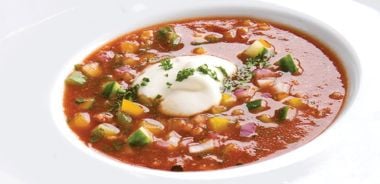Fiery Chipotle Gazpacho

Chipotles add smoky flavour to this soup, and are available in tins in the Mexican food section of many stores.
2 - 14 oz (298 mL) cans fire-roasted tomatoes, including juices
1/2 cup (125 mL) yellow pepper, finely diced
1 cup (250 mL) English cucumber, finely diced
1/2 cup (125 mL) red onion, finely chopped
1 canned chipotle chili in adobe sauce, finely minced
1 cup (250 mL) cold vegetable broth
1/4 cup (50 mL) extra-virgin olive oil
Freshly squeezed juice of 1/2 lemon
2 Tbsp (30 mL) balsamic vinegar
1/4 cup (60 mL) finely minced fresh herbs such as parsley, oregano, and basil
2 Tbsp (30 mL) Worcestershire sauce
Freshly ground black pepper
2 large cloves garlic, smashed and minced
Sea salt
1 hard-cooked egg
1 - 46 oz (1.36 L) can tomato juice (about 5 1/4 cups)
1/3 cup (80 ml) panko (Japanese breadcrumbs)
Salt and freshly ground black pepper
Balkan-style plain yogourt (optional)
Dice fire-roasted tomatoes. Place in large deep bowl along with juices, remaining diced vegetables, and chipotle chili. Stir in cold vegetable broth, oil, lemon juice, balsamic vinegar, herbs, and Worcestershire sauce. Add pepper to taste. Set aside.
Place smashed garlic in small bowl and sprinkle with a little sea salt. Chop egg and add to garlic. Mash with fork until blended.
Stir tomato juice into vegetable mixture along with egg mixture. Stir in breadcrumbs until dissolved. Add salt and pepper to taste. Cover; refrigerate overnight for flavours to blend. Serve with dollops of yogourt.
Makes 12 cups (3 L).
Each serving contains: 71 calories; 2 g protein; 4 g total fat (1 g sat. fat, 0 g trans fat); 9 g carbohydrates; 1 g fibre; 141 mg sodium
source: "Summer Soups", alive #334, August 2010





